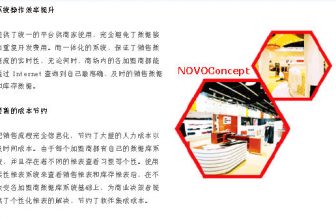
French jewelry retailer UHF RFID system application case
[ad_1]
French jewelry retailer Cleor reports that since the introduction of RFID systems in 10 of the company’s 50 stores nearly a year ago, inventory checks have only taken a few hours, compared to days before the technology was adopted. This solution has been installed in Cleor’s Paris distribution center and 10 stores for 8 months, and is now being installed in 40 other retail locations of the company.
Cleor has been selling jewelry in Paris and other cities in western and northern France for more than 10 years. By the end of 2011, the company intends to add 10 more stores. Currently, the company sells approximately one million pieces of jewelry each year. Cleor’s distribution center receives bags of jewellery shipped from suppliers in Europe and Asia. Each bag contains up to 100 pieces of jewellery. The staff of the distribution center must open the bag and check each jeweler with the order placed by the jeweler. To this end, the staff must scan the bar code label on each item to record the receipt of the goods in the company’s back-end management system.
Then some of these jewels are stored, and some (usually 20 to 30 jewels) are put in smaller bags and shipped to retail stores. When the store receives the goods, the staff scans the bar code of each item to confirm the arrival time of the item, and conducts regular store inventory checks to determine which items are in the storage room and which items are in the store. The bar code label is very small and requires a lot of manual labor by the staff to confirm that every bar code label on the jewelry can be scanned. This process is time-consuming for receiving goods and inventory checking, and errors are unavoidable when the barcode is illegible or not scanned accidentally.
Cleor is trying to replace the existing system with an RFID system. It needs a solution that is easy to install without disrupting the existing management process.
This RFID system includes custom reader antennas provided by Tageos, RFID readers provided by Impinj, and RFID-enabled handsets provided by Psion Teklogix.
The solution was installed by Frequentiel and needs to be integrated with Cleor’s existing enterprise resource planning (ERP) software, so that the store does not need to change the existing management process. This solution also requires hardware that can read very small RFID tags in distribution centers and stores, and at the same time ensure that only the tags on one item are read at a time during inventory checks in stores, so that the staff can compare items and pictures to Verify that the label on one item is not reversed with the label on other items. Frequentiel and Tageos have developed a reader antenna for Impinj’s Speedway Revolution reader, and Psion Teklogix’s handheld has a built-in Impinj reader chip. The system also uses six Toshiba RFID label printing encoders.
Lucien Repellin, vice president of business development at Tageos, said that in order to read very small RFID tags in a dense pile of jewelry in the distribution center, Tageos designed the Cube, a 12-inch metal box with an RFID antenna. , Can obtain label information from multiple angles. This Cube is connected to an Impinj reader, which can read RFID tags on 100 plastic bags filled with jewelry.
Cleor’s distribution center uses 6 label printing encoders to write a unique identifier on Tageos’ UHF EPC Gen 2 passive labels and print a barcode version with the same ID number on the label. . The barcode is used for backup in case the RFID reading fails. The distribution center then transmits these RFID tags to the relevant suppliers. Currently, approximately 65% of suppliers send labeled items to Cleor, and Cleor hopes that this number will eventually rise to 100%. When the distribution center receives a bag of jewelry from the supplier, the staff only needs to put the jewelry in the RFID Cube. Then Frequentiel’s software connects the ID number of each jewelry tag in the bag with the jewelry stock-keeping unit (SKU), description and picture, and stores them in the management software provided by Odeis in Cleor.
When the distribution center receives a bag of unlabeled jewellery, the staff attaches an RFID tag to each item, uses the same Toshiba device to encode and print the label, and compares the ID number of each tag with the SKU and other items in the Odeis system Information is connected. Then the newly labeled items are put back into their respective bags and placed in the Cube. Once Cube reads the tag of each item, the status of the item is updated in the management software, indicating that the item has been received by the distribution center.
When a store places an order, the staff in the distribution center finds the jewelry needed in the order and puts them in a small bag. Then these bags are placed on a 1 square foot RFID mat with an embedded Tageos RFID reader antenna connected to Impinj’s reader (the mat is chosen here because the smaller bag contains the tag Also less, RFID mats are more suitable and save money). When the mat reads the label, the Frequentiel software obtains the ID number, and connects the ID number to the SKU and other marks in the Odeis software again, and then confirms the accuracy of the order, and updates the status of the item when it is shipped out.
In each store, the same type of Tageos mat antenna and Impinj reader are used to receive items from the distribution center. Jewelry bags are placed on the mat, the label reading results are transmitted to the Odeis system, indicating that they have been received by the store, and then the items are placed in the showcase. To complete the inventory of the items in the showcase, the staff used a Psion Teklogix handheld with an antenna shaped like a large toothbrush, and its reading distance was set to 5 cm to ensure that only one tag was read at a time. When the staff swept over each tag with the antenna, the screen of the handset showed the description and pictures connected with the tag ID number, so the staff could verify which item the tag belongs to. The ID number of each tag stored by the reader software is also read. After completing the inventory check, the staff plugged the reader into the personal computer, and the inventory list was uploaded to the Odeis software. If something is missing, it will be displayed on the computer screen.
At the point of sale, when an item has been purchased, it is placed on the same mat antenna, and the tag ID number of this item is obtained and transmitted to the back-end system, thereby indicating that the item has been sold. Before the customer leaves the store, the label on the jewelry is removed and then discarded.
Repellin said that although the RFID system saves man-hours, the biggest value of the system is to improve accuracy for Cleor.
Aurelien Senechal, managing director of Cleor, also expressed his appreciation for this system. He said that this innovative RFID solution has reformed the process of the jewelry industry.
[ad_2]





